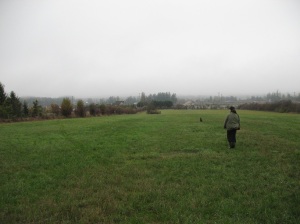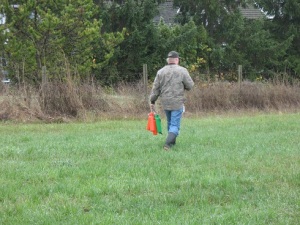A friend recently had an interesting request: could he use our fields through the winter to do retriever training with his labradors?
We agreed, and they came the first time a couple of weeks ago. R is training these dogs for retriever competitions, but he will also use them for some duck hunting for his freezer. I got to watch R and a friend when they came two weeks ago, a very wet day, and learned quite a lot from them about what’s involved. And then I got to watch again today, when R and his wife came. It was grey but dry, much better for some pictures.
R has 5 dogs, mostly chocolate labs, 1 yellow lab. They range in age from puppy to 6 years, and their focus, stamina, and attention to their owner are reflected in their relative age.
Out in the field, training involves the owner, a helper and about half a dozen “bumpers”. They look like small coloured boat fenders with a short cord. Some are covered in dull grey/green canvas to make them harder to see, and one today was a fake duck. The owner and helper wear walkie talkies and dog whistles. Today R used a duck caller as well.
The dog is required to sit beside one person calmly waiting for a signal to move. The other person walks well down the field – our field is about 10 acres, and he went about 2/3 the way down. Once down there he confirms by walkie talkie that the dog is still in control, then uses the duck call to alert the dog, and throws the first bumper out away from himself. The person with the dog releases the dog by sayings it’s name and the dog shoots down the field like an arrow, heading straight for the bumper. As soon as he’s picked it up, the person at the top of the field whistles and calls the dog back. On arrival the dog is expected to heel and sit, still holding the bumper until told to “give”. It gets thrown behind them and the process begins again.

Click to enlarge; R is down the field near the perimeter hedge. Sarge is pounding toward the bumper that R just threw near the clump of bushes further away
Sometimes the person throwing the bumper does things like hide in the hedge, and then throw the bumper. Tricky. Sometimes the bumper is thrown, but the dog is not released. A second bumper gets thrown, and the dog is released to go get the more recent bumper, bring it back, heel, sit, give and then release to go find the first one. That’s a huge test. Half the time, I couldn’t remember where it had landed myself. The dog has been trained to listen to the owner for hints, so if it really isn’t finding the bumper, a whistle will make it stop and look to the owner who will whistle again while pointing to the right area.
Each dog probably does about 6 or 7 retrievals, always at top speed, and they’re pretty tuckered by then. But the reward for all that work is some fun with chasing the bumpers the way the rest of us would throw a ball or a stick for a dog, and the labs just love it, dancing and bouncing like they hadn’t seen such a fun thing to do in years.
Even to my untrained eye, the difference in ability between the dogs is apparent. Sarge, the male dog I watched today, was tense and focused, really working to not lose track of the bumper when it was thrown. Star, the female, was far less focused, and kept wanting to return the bumper to R, who was the bumper thrower today, rather than back to the top of the field, to R’s wife. So breeding, gender, training, and just the individual dog’s personality all play a part in whether a dog develops as a great retriever or not.
A bonus of the dogs appearing frequently in our fields like this is that we’ll probably be blackmarked by the local Canada goose population, and that’s a good thing.




